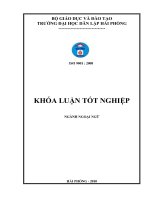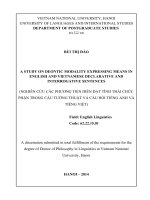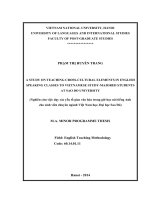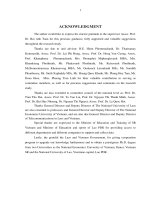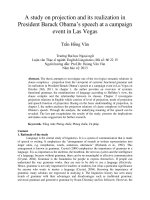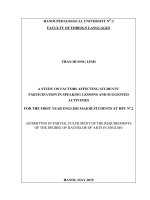A study on instruments of trade financing in vietnamese commercial banks
Bạn đang xem bản rút gọn của tài liệu. Xem và tải ngay bản đầy đủ của tài liệu tại đây (1.46 MB, 106 trang )
MINISTER OF EDUCATION AND TRAINING
FOREIGN TRADE UNIVERSITY
MASTER THESIS
A study on instruments of Trade financing in Vietnamese
commercial banks
Major: International Trade Policy and Law
Full name
: Duong Thuy An
SUPERVISOR
: Asso. Prof, Dr. Nguyen Thu Thuy
Hanoi - 2016
ACKNOWLEDGEMENT
Firstly, I would like to send my profound regards to my supervisor, Asso.
Prof, Dr. Nguyen Thu Thuy, for all of her remarks and guidance so that I can
continue doing my research and complete this on time.
I also would like to thank my friends working with me in trade financing field
for their strong support. Without them, the study would not be accomplished.
Lastly, I would like to take this chance to express my deepest gratitude to my
dear family, who always supports me no matter what happens for all the time I
study. I would like to sincerely thank my parents, for giving me unconditionally
loving and encouraging me through my hardest time; my sister, for truly
understanding and sympathizing with me. I would never have finished this without
you.
TABLE OF CONTENTS
LIST OF FIGURES
ABSTRACT ...................................................................................................... 1
CHAPTER 1: INTRODUCTION ................................................................... 2
1.1. Relevance of study ...................................................................................... 2
1.2. Research questions ...................................................................................... 5
1.3. Data and methodology................................................................................. 6
CHAPTER
2:
THEORETICAL
FRAMEWORK
OF
TRADE
FINANCING INSTRUMENTS ............................................................................... 8
2.1. Methods of settlement ................................................................................. 8
2.2. Methods of secondary payment ................................................................. 14
2.3. Methods of finance for customers ............................................................. 16
2.4. Methods of finance for banks .................................................................... 27
CHAPTER 3: LEGAL FRAMEWORK OF TRADE FINANCING
INSTRUMENTS ..................................................................................................... 31
3.1. National law............................................................................................... 31
3.1.1. General law ........................................................................................... 31
3.1.2. Specific law for each kind of trade financing instrument .................... 32
3.2. International law ........................................................................................ 35
3.3. Relationship between national law and international law of trade financing
instruments
........................................................................................................... 38
3.4. Effect of law in trade financing instruments ............................................. 39
CHAPTER 4: DEVELOPMENT AND IMPACT OF TRADE FINANCING
INSTRUMENTS TO VIETNAMESE COMMERCIAL BANKS .......................... 43
4.1. Development of Trade financing instruments in Vietnamese commercial
bank………… ........................................................................................................... 43
4.1.1. Financing by issuing or confirming Letter of credit ............................. 43
4.1.2. Discount/negotiation .............................................................................. 44
4.1.3. Guarantee/Standby L/C .......................................................................... 46
4.1.4. Express discount ..................................................................................... 47
4.1.5. L/C used for financial purpose ............................................................... 48
4.1.6. Usance L/C at sight basis ....................................................................... 50
4.1.7. Internal L/C ............................................................................................ 58
4.1.8. Products for loaning purpose between banks ........................................ 61
4.1.9. Factoring ................................................................................................ 62
4.1.10. Forfaiting .............................................................................................. 65
4.1.11. Supply chain ......................................................................................... 69
4.2. Impact of trade financing instruments to banking business ...................... 74
CHAPTER 5: ANALYSIS ON THE CURRENT SITUATION OF
TRADE FINANCING INSTRUMENTS AND RECOMMENDATIONS FOR
DEVELOPING TRADE FINANCING INSTRUMENTS IN VIETNAMESE
COMMERCIAL BANKS ....................................................................................... 78
5.1. Analysis on the current situation of Trade financing instruments in
Vietnamese commercial banks .................................................................................. 78
5.2. Success and shortcomings of trade financing instruments in Vietnamese
commercial banks ...................................................................................................... 84
5.3. Recommendations for Vietnamese banks in developing trade financing
instruments …. .......................................................................................................... 87
CHAPTER 6: CONCLUSION ...................................................................... 93
REFERENCES ............................................................................................... 94
LIST OF ABBREVIATIONS
ADB
Asian Development Bank
Agribank
Vietnam Bank for Agriculture and Rural Development
AML
Anti-Money Laundering
BIDV
Bank for Investment and Development of Vietnam
BPO
Bank payment obligation
CCC
Commodity Credit Corporation
CDCS
The Certificate for Documentary Credit Specialists
DOCDEX
Documentary Instruments Dispute Resolution Expertise
Exim bank
Vietnam Export Import Commercial Joint - Stock Bank
EPLC
Early payment letter of credit
FMCG
Fast moving consumer goods
GSM 102
Export Credit Guarantee Program 102
ICC
International Chamber of Commerce
IFC
International Finance Corporation
IFC
International Finance Corporation
IMO
International Maritime Organization
ISBP 745
International Standard Banking Practice for the Examination of
Documents under Documentary Credits 745
ISP 98
International Standby Practices 98
KYC
Know your customer
L/C
Letter of credit
MB
Military Bank
OCR
Optical character recognition
RM
Relationship Manager
RMA
Relationship Management Application
SCF
Supply chain finance
SCM
Supply chain management
SLA
Service Level Agreement
SWIFT
Society for Worldwide Interbank Financial Telecommunication
TMA
Transaction Matching Application
TPP
Trans Pacific Partnership
TSU
Trade Services Utility
UCP600
Uniform Customs and Practice for Documentary Credit 600
UPAS L/C
Usance payable at sight letter of credit
URBPO 750
Uniform Rules for Bank Payment Obligations 750
URC522
Uniform rules for collection 522
URDG 758
Uniform Rules for Demand Guarantees 758
URF 800
ICC Uniform Rules for Forfaiting 800
URR725
Uniform rules for bank to bank reimbursement 725
USDA
U.S. Department of Agriculture
Vietcombank
Joint Stock Commercial Bank for Foreign Trade of Vietnam
Vietinbank
Vietnam Joint Stock Commercial Bank for Industry and Trade
VP bank
Vietnam Prosperity Joint-Stock Commercial Bank
LIST OF FIGURES
Figure 1. Bank payment obligation transaction flow ................................................ 10
Figure 2. Documentary credit without confirmation of advising bank ..................... 13
Figure 3. Payment secured by a bank guarantee (or Standby letter of credit) .......... 15
Figure 4. Close 3-corner Supply chain flow ............................................................. 21
Figure 5. Open 4-corner Supply chain flow .............................................................. 23
Figure 6. Basic forfaiting transaction ........................................................................ 25
Figure 7. Comparison between methods of finance .................................................. 26
Figure 8. UPAS L/C mechanism ............................................................................... 54
Figure 9. Bank spending on block chain ................................................................... 71
Figure 10. Market adoption of BPO .......................................................................... 72
Figure 11. The revenue potential from supply-chain ................................................ 73
Figure 12. Non-interest income................................................................................ 76
Figure 13. Global trade finance revenue .................................................................. 78
Figure 14. Mix trade finance product ........................................................................ 79
Figure 15. Trade-related revenues for banks ............................................................ 80
Figure 16. Techcombak’s volume of Trade finance instruments ............................. 82
1
ABSTRACT
The academic research analyzes some trade financing instruments’ processes
and focuses on modern trade financing instruments like L/C for financing purpose,
Forfaiting, Supply chain, which are developed in the world but limited in
Vietnamese commercial banks. In addition to bringing out the impact of trade
financing products on business of Vietnamese commercial banks, the study also
points out success and shortcomings of trade financing activities in Vietnamese
banking business and proposes suggestions to increase trade finance in Vietnamese
banking system.
Moreover, this dissertation would like to mention all recent national laws and
international rules for each product and also indicates their affect to trade financing
processes in Vietnamese commercial banks. So that, bankers can get a whole view
on a legal aspect of trade financing instruments.
This paper will approach a different view with previous researches by deeply
focusing on specific trade finance products and study with the scope in Vietnamese
commercial banks like Vietcombank, Techcombank, MB, VP bank,… in
comparison with international banks. Thus, this paper would like to be a useful
source for bankers, especially trade financing officers, RM to develop trade
financing procedures as well as operate them efficiently.
2
CHAPTER 1: INTRODUCTION
1.1.
Relevance of study
Nowadays, trade finance business has become one of the most important
portfolios in Vietnamese commercial banks. According to the ICC Global Survey
on Trade finance 2016, Growth in trade finance transactions both in volume and
value terms is no longer predominantly driven by China. An increase in activity in
South-East Asian countries is noticeable, with Vietnam in particular powering
ahead. As per Vietcombank’s the first six-month business report in 2016,
Vietcombank’s Trade finance value reached 24.802 million USD, Vietinbank
gained 17 million USD and BIDV got 10 million USD, which is significant revenue
in comparison with import-export volume-159.9 million USD1.
The developing trend of Vietnamese commercial banks in trade finance field
is diversification of products since it is an important factor that creates difference
among banks. Trade finance products do not stop at traditional way but more
efficient way. In tradition, to finance, banks can use their capital (namely
negotiation of exporting documents or lending loan to customers for payment under
L/C) or their credit to finance customers (like issuing L/C, Standby L/C or
Guarantee). However, nowadays, banks offer more modern products like express
negotiation which is based on normal negotiation but it is more efficient to help
companies get money quickly. Therefore, with a wide range of trade finance
products, it is a hard job for banks to offer suitable products for their customers
since enterprises only care about trading process and leave financing issues for
banks.
Moreover, the need of enterprises from banks is more complicated in the
booming period of trade and enterprises are usually customers of different banks.
Hence, companies can compare trade financing instruments between banks. As a
result, it is a pressure for banks to continuously update information on new products
1
Vietcombank (2016), The first six-month business report in 2016
3
and develop its own instruments. For example, UPAS L/C is so familiar to
Vietnamese commercial banks thanks to its win-win mechanism (UPAS L/C is
payable sight basis to the seller (beneficiary), while the payment settlement from the
applicant (buyer) to the issuing bank will made at the end of usance term).
However, although used in other countries long time ago (i.e. Korea), at the time of
2011, UPAS L/C was an exclusive product of Techcombank. It took almost five
years for this kind of L/C become popular in Vietnamese commercial banks. The
same situation applied with Draft by back L/C which has same mechanism with
UPAS L/C but the issuing bank has the role of reimbursement bank. Till now, only
Techcombank and MB offer this product. Moreover, some products like Supply
chain, Forfaiting have not been developed in Vietnam.
Since Vietnamese legal structure is so complex with a lot of Circulars,
Decisions, Official notices… which are revised or replaced in each period of time, it
is required that banks must update new rules governing their trade financing
products. So that, they are able to build up or update their procedures in compliance
with new regulations.
Researches on trade financing instruments are done in various ways from
theoretical view and practical view. For example, Mustafa (2010), Ahn & JaeBin
(2011) and Grath (2013) provide all theories of trade finance. There are some
papers in a practical aspect like Henri (2013) indicating practical process in trade
financing unit from the perspective of corporate banking employees or Sindberg
(2011) and Oramah (2016) providing financing activities in international trade. In
the financial crisis, trade financing activities were researched increasingly like
Rochet (2010), Chauffour & Malouche (2011), Chor & Manova (2012), all of which
shown the fact that because of crisis, bank-intermediated trade finance fell in value
significantly. In addition, analyses on development of trade finance are also
mentioned by many authors namely Clark (2014) and Garralda& Vasishtha (2015).
Moreover, the importance of trade finance in trading activities is also proved in a
variety of researches namely Wandhöfer (2012) and Prete & Federico (2014).
4
As to categorical aspect, ICC have annually issued ICC Global Survey on
Trade finance to update new products and trade financing trend of the world in each
period of time. For example, ICC Global Survey on Trade finance 2016 gives a
view of development of new technique like BPO from 2014 to 2015 and growth of
new trade finance products like Forfaiting. According to this report, the market
uptake for the Bank Payment Obligation did not experience significant increase
during the calendar year 2015, demand for BPO in 2015 following a similar trend in
2014. While nearly 80% reported no change in their use of this instrument, nearly
15% reported an increase2. Growth of Forfaiting in all regions has been observed,
however, relative to 2014. Not mention to some researches on specific products like
Frederic (2016) introducing supply chain management technologies and Surbhi
(2016) analyzing the difference between Factoring and Forfaiting.
Moreover, the development of trade finance field in Vietnamese banking
system has been researched from time to time. For instance, Doan Thi Nuong
Nuong (2012) provides some solutions to develop trade finance in Vietnamese
commercial banks and Pham Thi Thu Hang (2015) focuses on how to manage risks
in trade finance field. In the newest research, Nguyen Thi Ha (2015) indicates
development of trade finance in Vietnamese commercial bank with analysis on
some modern trade finance products like UPAS L/C, Draft buy back L/C, Trade
loan and L/C Refinancing.
With a wide range of previous researches, bankers can get a lot of information
on trade finance field especially trade finance instruments. However, not mention to
the fact that all previous researches do not provide mechanism of trade finance
products in practical view, like all products, trade finance instruments are updated
in an increasing pace. Therefore, the previous researches do not contain sufficient
updated data for readers. Because of the gap and the fact that the current trend to
develop trade financing section of banks is diversifying products, this dissertation “A study on instruments of Trade financing in Vietnamese commercial banks” is written .
2
ICC (2016), Global Survey on Trade finance 2016
5
This paper would like to provide bankers, in view of a trade finance officer, detailed
process of new trade financing instruments like L/C for financing purpose,
Forfaiting, Supply chain. With this information, the research would like to be a
useful source for bankers to develop trade financing procedures as well as operate
them efficiently.
In legal aspect, although Vietnamese legal framework is quite complex, there
is no previous research analyzing national laws and international rules governing
each trade financing instruments. Therefore, this dissertation would like to mention
all recent national laws and international rules for each product and also approach
their affect to trade financing process in banks. Thus, trade financing officers can
have a whole view on legal regulations which govern and guide trade financing
activities.
Moreover, unlike other researches which only analyze development of trade
finance field as a whole, the paper will get a close look on the impact of trade
financing instruments to commercial banks’ business and aim to give
recommendations to develop trade financing products in Vietnamese banking
systems. With that purpose, the paper will indicate newest information of benefits
which trade financing instruments create, limitation of some trade financing
procedures in different banks.
1.2.
Research questions
To shed light to the above mentioned issues, the study will be answers for the
following questions:
How do banks offer and use their trade financing products for their
customers and their own needs?
What are recent national laws and international rules for each trade
financing instrument?
What is the impact of trade financing instruments on the success of
Vietnamese commercial banks?
6
What are the recommendations for Vietnamese commercial banks in
developing their trade finance instruments?
1.3.
Data and methodology
The author used the following methods to answer four research questions:
a) Statistic method: data collected from annual report of some commercial
banks, data of finance institutions and corporations like ICC…
b) Investigation method: Investigate trade finance activities in some
Vietnamese commercial banks and foreign banks.
c) Comparison and collective method: collect information from related
researches, compare status of trade finance in commercial banks and
collect the results to find out the solutions.
The scope of study is in Vietnamese commercial banks like Vietcombank,
Techcombank, MB… which represent big four state-owned banks, foreignshareholder banks and big corporation banks respectively, in comparison with
international banks and focus on trade financing sector. The dissertation is studied
with data from the period of 2010-2016 and will give suggestions till the period of
2025 in which Vietnamese banking system is predicted to pass difficulty and grow
steadily.
With a view to addressing these problems, the research will be divided into six
main sections. Firstly, Chapter 1 will be Introduction giving an overview on the
study. Following Chapter 2 will be Theoretical framework of trade financing
instruments, showing mechanisms of trade financing instruments. Chapter 3 will be
Legal framework of trade financing instruments, providing update regulations for
trade financing instruments and effect of them. Furthermore, Chapter 4 is
Development and impact of Trade financing instruments to Vietnamese commercial
banks, aiming to provide a practical view of each product in Vietnamese
commercial banks in comparison with that of foreign ones. Chapter 5 Analysis on
the current situation of trade financing instruments and recommendations for
developing trade financing instruments in Vietnamese commercial banks will point
7
out current situations and some recommendations for developing trade financing
products in Vietnamese banking system. Finally, Conclusions will be drawn and
recommendation for further research will be presented in the last Chapter 6, along
with the limitations of this study.
8
CHAPTER
2:
THEORETICAL
FRAMEWORK
OF
TRADE
FINANCING INSTRUMENTS
2.1. Methods of settlement
Each kind of trade financing instruments is based on basic payment terms. The
five basic terms of payment are Open account, Documentary collection, BPO, L/C
and Payment in advance.
Open account
In an open account transaction, a seller will dispatch goods to a buyer and
send documents (shipping documents and/or customs documents) asking for
payment or agreement to pay on a specified date. Once goods have been dispatched,
a seller will lose all control over payment, and is reliant on the trustworthiness and
creditworthiness of a buyer to pay. Therefore, this kind of payment is only a
convenient method of payment if a buyer is well established, has a long and
favorable payment record.
Open account terms may be offered with use of one or more of trade financing
techniques namely Guarantee/Standby L/C, Factoring, Forfaiting and Supply chain
to reduce risks and provide advance payment for exporters.
Documentary collection:
In a documentary collection, a seller will ship or dispatch goods. However,
instead of sending documents directly to a buyer, it will send them via a banking
system for payment or acceptance by a buyer.
URC 522 (ICC, 1995) sub-article 2 (a) defines a collection as being: handling
by banks of documents . . . in accordance with instructions received, in order to:
(I) obtain payment and / or acceptance, or
(II) deliver documents against payment and / or against acceptance, or
(III) deliver documents on other terms and conditions.
9
More commonly, collections are described as being ‘D/P’ - documents release
against payment, ‘D/A’ - documents release against acceptance, with payment due
at a future date or ‘D/OT’ - documents release against other terms and conditions
namely promissory notes, trust receipts, letters of under taking to pay,…
Enterprises can get finance from this kind of payment method like negotiation
for exporters and a loan for importers to effect payment. In D/A transactions,
exporters may require Guarantee/Standby L/C to reduce risks of non payment at
maturity from importers.
Bank payment obligation:
URBPO 750, article 3 defines that BPO (bank payment obligation) is an
irrevocable undertaking given by one bank (Obligor bank) to another bank
(Recipient bank) that payment will be made on a specified date after a successful
electronic matching of data.
BPO is a new tool for international trade finance. It will be located somewhere
between open account and letter of credit. Based on standardized messaging and
advanced transaction matching, this new instrument will accelerate financial supply
chain.
The process flow of a basic BPO transaction is illustrated in Figure 1 below.
10
Figure 1. Bank payment obligation transaction flow3
(1) The buyer and the seller agreed on BPO as a payment term on the sales
contract.
(2) The buyer provides minimum data from the sales contract and conditions
of BPO to the obligator bank which will inform the recipient bank.
(3) The recipient bank advises the seller BPO conditions. The seller confirms
the data and sends its acceptance of BPO conditions to the recipient bank. If both
buyer's and seller's data are matched on the Transaction Matching Application
(TMA), the baseline is established. At that moment, an irrevocable undertaking of
the obligor bank is issued. Then, both buyer and seller will be receiving a matching
report from their banks.
An example of a TMA is the SWIFTNet Trade Services Utility (TSU) which is
a centralized matching and workflow engine. The obligor bank and the recipient bank
communicate in a BPO transaction by a set of ISO 20022 messages-Trade services
management (TSMT). Communication systems for BPO are operated by Society for
Worldwide Interbank Financial Telecommunication SWIFT).
3
Mark Ford (2014), First German-Japan BPO processed, DCInsight Vol.19
11
(4) The seller ships the goods as agreed on the sales contract.
(5) The seller presents shipment data and invoice data to its bank (the recipient
bank), which submits them to Transaction Matching Application for matching.
(6) The buyer receives a match report from its bank (the obligor bank). The
buyer is invited to accept any mismatches if any.
(7) The recipient bank informs the seller about the successful dataset match.
(8) The seller sends trade documents directly to the buyer. The buyer will clear
goods from the customs with these documents.
(9) On the due date, the obligor bank debits the proceeds from the buyer's
account to effect payment for the recipient bank.
It is noticeable that, unlike an LC, where the seller in the underlying trade
transaction is the beneficiary, the party entitled to payment under a BPO is the
recipient bank (the seller's bank). This is because a BPO creates a bank-to-bank
payment obligation, not a bank-to-customer obligation. Therefore, a BPO offers
assurance of payment, risk mitigation for all parties, and is possibly used as
collateral for finance. In addition, the obligor and recipient banks need separate
agreed documents with their customers in respect of a BPO since the actual parties
of this payment method are the seller and the buyer.
Letter of credit:
The definition of letter of credit, offered in UCP 600, article 2, is a short and
definitive statement: “Credit means any arrangement, however named or described,
that is irrevocable and thereby constitutes a definite undertaking of the issuing bank
to honor a complying presentation”
The structure of a basic documentary credit transaction is highlighted in
Figure 2.
(1) The contract is agreed between the buyer (‘applicant’) and the seller
(‘beneficiary’) indicating a documentary credit as the method of settlement.
12
(2) The applicant applies to its bank for the issuance of a documentary credit,
usually by completing the bank’s standard application form.
(3) Subject to a credit facility being in place and the bank agreeing to the
terms and conditions that have been stated in the application form, the bank issues
the documentary credit and advises it through a bank in the country of the
beneficiary, known as the ‘advising bank’.
(4) The advising bank issues its advice of the documentary credit and sends it
to the beneficiary.
(5) The beneficiary, if in agreement with the terms and conditions of the
documentary credit, arranges shipment of the goods.
(6) Having shipped the goods, the beneficiary issues, collates and presents the
documents stipulated in the documentary credit to the advising bank, which is also
the ‘nominated bank’ named in the documentary credit.
(7) Because the advising bank has not added its confirmation to the credit, it
may or may not examine the documents prior to sending them to the issuing bank. It
is also under no obligation to honor or negotiate the beneficiary’s documents. We
will assume that the advising/nominated bank has not examined the documents.
(8) The issuing bank determines that the documents comply and arranges to
debit the applicant’s account for the value of the drawing. In return, the documents
are handed over to the applicant so that it may take control of the goods. At the
same time, the issuing bank reimburses the advising/nominated bank.
(9) The advising/nominated bank, upon receipt of the proceeds from the
issuing bank, effects settlement to the beneficiary in the manner requested.
This is a basis flow of L/C transaction. There may involve a confirmation bank
which like the issuing bank gives its irrevocable undertaking and a reimbursing
bank which is the third party to effect payment.
Letter of credit can be used for almost trade finance activities because of its
efficient features which are presentation of
documents to prove transactions,
13
independent parties like the issuing bank/the confirming bank giving irrevocable
undertaking, or the nominated bank/the reimbursing bank effecting payment.
Figure 2. Documentary credit without confirmation of advising bank4
Payment in advance:
With this method of payment, the buyer pays the money in advance. Once the
seller is in receipt of the funds, it arranges for the goods to be shipped or dispatched.
From the seller’s point of view, receiving payment in advance of the shipment is an
4
Gary Collyer. (2015), Guide to Documentary Credits, 5th edition, ifs University College
14
ideal situation, as it appears to eliminate all risks associated with nonpayment.
However, from the buyer’s point of view, payment in advance carries
the greatest risk, as it is wholly dependent on the seller shipping the correct goods
in accordance with the contract. In addition, payment in advance can create cashflow problems for the buyer, as it has to wait to receive the goods. Therefore, the
buyer usually required bank guarantee or stand-by L/C to reduce risks.
2.2. Methods of secondary payment
In case another primary payment mechanism does not work, a party of
contract will get reimbursement from a third independent party by a Guarantee or
Standby letter of credit. Guarantee and Standby L/C have very similar
characteristics but they work in different mechanisms with particular uniform rules
for each kind. Standby L/C has its rules as ISP 98 - International Standby Practices,
ICC Publication No. 590 and the rules of Guarantees is the Uniform Rules for
Demand Guarantees, ICC publication No. 758
As per URDG 758, article 2 “ Guarantee means any signed undertaking,
however named or described, providing for payment on presentation of a complying
demand”. ISP98 rules (1998) includes reference to Standby letters of credit in the
following terms: Irrevocable-Rule 1.06b says: ‘‘Because a Standby is irrevocable,
an issuer’s obligations under a Standby cannot be amended or cancelled . . . except
as provided in the Standby or as consented to by the person against whom the
amendment or cancellation is asserted’’. For the purpose of demonstrating this
transaction, Figure 3 uses a bank guarantee as an example, but the process could
equally applies to a Standby letter of credit.
15
Figure 3. Payment secured by a bank guarantee (or Standby letter of credit)5
(1) The contract is agreed between the buyer and seller, indicating open
account terms or a documentary collection as the method of settlement, supported
by a bank guarantee.
(2) The buyer applies to its bank for the issuance of a bank guarantee, usually
by completing the bank’s standard application form.
(3) Subject to a credit facility being in place, and the bank agreeing to the
terms and conditions that have been stated in the application form, the bank issues
the guarantee and advises it through a bank in the country in which the beneficiary
is located, known as the ‘advising bank’.
(4) The advising bank issues its advice of the guarantee and sends it to the
beneficiary.
(5) The beneficiary, if in agreement with the terms and conditions of the
guarantee, arranges shipment of the goods. Having shipped the goods, the
5
Gary Collyer. (2015), Guide to Documentary Credits, 5th edition, ifs University College
16
beneficiary issues, collates and presents its documents directly to the buyer (open
account terms) or to the remitting bank (if documentary collection terms) for
sending to the collecting bank.
(6) If the open account transaction, or the documentary collection, is honored,
the guarantee is not utilized. If there is a payment default by the buyer, the seller
issues a demand in accordance with the requirements of the guarantee and presents
it to the advising bank.
(7) The advising bank sends the demand to the issuing bank.
(8) The issuing bank determines that the demand complies and arranges to
debit the applicant’s account for the value of the drawing. In return, the demand is
handed over to the applicant. At the same time, the issuing bank reimburses the
advising bank.
(9) The advising bank, upon receipt of the proceeds from the issuing bank,
effects settlement to the beneficiary in the manner requested.
The two instruments are not only used to finance enterprises by banks’ credit
but also used in connection with other kind of instruments. For instance, some
banks required a Guarantee or Standby L/C issued by reputed financial institutions
before providing reimbursement under UPAS L/C or Trade loan/Refinancing.
2.3. Methods of finance for customers
Negotiation/Discount
Discount is a method that banks will effect payment of drafts or documents at
a certain amount (i.e. 90% of invoice value) in advance and customers in return pay
back banks a principal amount plus interest. From that mechanism, discount can be
used in a wide range of trade financing transactions namely documentary collection,
letter of credit…
In letter of credit terminology, negotiation term is used instead of discount
term. UCP 600, article 2, defines “negotiation” as “Negotiation means the purchase
by the nominated bank of drafts (drawn on a bank other than the nominated bank)
17
and/or documents under a complying presentation, by advancing or agreeing to
advance funds to the beneficiary on or before the banking day on which
reimbursement is due to the nominated bank”
The structure of a basic discount transaction is described as below steps:
(1) The contract is agreed between the buyer and the seller indicating shipment
of goods and a payment activity
(2) The seller arranges shipment of the goods.
(3) Having shipped the goods, the seller issues, collates and presents
documents stipulated in the contract and presents the application for discount and
documents to its bank
(4) The bank reviews the application and the documents as per their policy
then agrees or disagrees the discount offer.
(5) When agreeing to discount, the bank pays the seller a percentage of
invoice value.
(6) The bank sends the documents to the buyer or the buyer’s bank and claims
for value of goods.
(7) The bank receives payment from overseas party and off balance the
amount with the seller.
(8) If The bank does not receive payment at maturity, it will recourse the seller
(in discount with recourse) or it will claim reimbursement from the buyer or buyer’s
bank (in discount without recourse).
As mentioned above, discount with recourse and discount without recourse are
two kinds of discount. In discount with recourse, the client is legally responsible for
repayment of the funds and the finance will be shown in the client’s balance sheet
as a liability. In discount without recourse, the client is not legally responsible for
repayment of the funds; banks have agreed to look to someone other than the client
for repayment (i.e. buyers or buyer’s bank) and the finance will not appear on the
18
client’s balance sheet as a liability provided that the client’s auditors are in
agreement.
Discount without recourse has higher risks for banks because it is easier for
banks to get repayment from their customers than from overseas parties. So that, to
get discount without recourse , there are requirement of higher interest and more
conditions like documents must be under L/C transactions, documents must be
accepted by issuing banks or confirming bank and credit line of issuing banks and
confirming banks and country risks must be complied with banks’ policy. The
requirement on overseas parties are difficult to get since they are changeable and
hard to analyze by banks. However, if banks are confirming banks under L/C
transactions, they must negotiate complying documents without recourse (as
stipulated in sub-article 8 (a) (ii) UCP 600). That is to say, the confirming bank is
exposed to risk of non-reimbursement from the issuing bank for whatever reasons.
Factoring
A factoring service is similar to discount except that the whole of
administration and credit control of the sales ledger are taken over by a factoring
company. For this reason, the provision of this facility must be known to the buyer.
The seller and the factoring company will need to agree precisely what services are
required and will be offered by the factor. Factoring is short-terms financing which
is usually not applicable to a small invoice because of the high charges will be
applied for the factoring administration.
The standard step by step invoice factoring process is as follows:
(1) A company (seller) sells goods or services to one of its customers (buyer)
as per the agreed terms and conditions.
(2) The seller ships goods, prepares documents and contacts his bank for
factoring service.
(3) The bank verifies the transaction and the background of the buyer.

